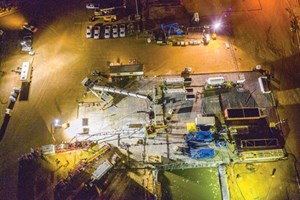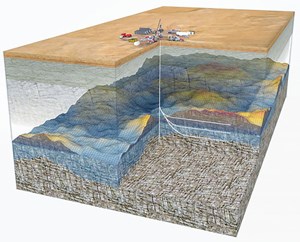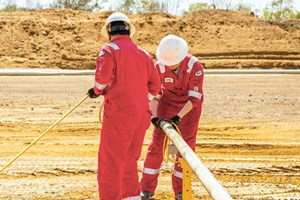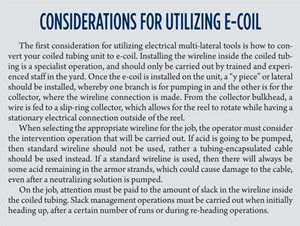Addressing the re-entry problem of barefoot multi-laterals on coiled tubing
Since the early 1990s, it has been increasingly common practice for operators to maximize well production by drilling multilateral wells that connect to the main motherbore. Multilateral well designs have been shown to improve production by accessing numerous production zones and increasing the reservoir contact of each well with minimal increase in drilling and completion costs, Fig. 1. While particularly beneficial in an offshore environment where well slots are limited, there are also significant advantages onshore, where the use of multi-lateral wells can significantly reduce the environmental impact in comparison to drilling multiple wells.
The technology and expertise required to drill and successfully complete these wells are now very advanced and well-understood. However, the ability to re-enter a chosen lateral successfully on the first attempt, and to validate that entry positively and quickly, has not advanced at the same pace. Most multi-lateral wells have horizontal or near-horizontal reservoir sections, which require coiled tubing in order to re-enter. As such, coiled tubing drilling (CTD) has been integral to multilateral well design since its inception. A typical multi-lateral well is shown in Fig. 2.
CTD has long been proven as a highly successful, cost-effective method of re-entering old wellbores and accessing bypassed and attic reserves, thus revitalizing depleted wells and providing operators with a high return on investment in their mature assets, Fig. 3. In addition to optimizing well lifetime, CTD technology offers the ability to drill underbalanced, maximizing the production of oil and gas per section of formation drilled (see Fig. 1 on location).
The incorporation of effective multi-lateral well design to CTD operations increases profitability even further by maximizing the length of productive reservoir rock drilled per motherbore. This combination of oilfield technology has been shown to be very effective in many locations, but most significantly in the UAE, Saudi Arabia and Alaska, USA, with many papers published detailing the benefit to the operators’ bottom lines.
The stimulation of intervention operations that an operator may want to carry out on an individual lateral is no different from the stimulation of a single wellbore in a conventional completion, except in regard to lateral entry and consideration of the interaction between laterals during stimulation. The most significant challenge and potential barrier to increasing multi-lateral applications is the difficulty in entering a desired lateral first time and then positively confirming which lateral has been entered. With open-hole sidetracks in a horizontal section, the lateral will drop down, and it will be impossible to enter the original lateral with a drilling assembly. Even a motor on a maximum bend setting will not be sufficient.
HYDRAULIC SYSTEMS
The most common method for accessing the chosen lateral is to use an indexing tool and pressure-actuated knuckle to kick off. An indexing tool works by rotating the BHA by a set amount, as pumps are cycled. In other words, pressure is applied through pumping, released by stopping pumps and then applied again through re-starting pumping. With certain tools, the amount of rotation on each pressure cycle can be set on surface prior to running in hole.
A pressure-actuated knuckle kicks off a bullnose beneath the knuckle, at a set angle, by utilizing a differential pressure across the knuckle. It is important that the knuckle and the length of bullnose are sized according to the hole geometry and BHA size. Due to the reduced flowrate through the tools while the knuckle is in use, the BHA usually includes a pump-out choke, which can be sheared out to enable higher flowrates for cleaning out the well, once the desired lateral has been located.
The procedure for utilizing a pressure-actuated knuckle system is to run in hole until the BHA is past the kick-off point or junction. The pumps should then be started, and the BHA should be pulled out of hole slowly. As the knuckle and bullnose are in the motherbore at this point, the bullnose cannot fully kick off. This results in a high differential pressure, which will be shown on surface as higher pump pressures.
As the BHA is pulled out of hole while pumping, if the knuckle has been oriented in the correct direction, then the bullnose will kick off by the maximum degree into the lateral, and bleed ports will be opened. This will reduce the pressure drop across the knuckle and provide a positive indication at surface that the window has been found. If no pressure drop is detected, then the process is repeated (possibly multiple times): run in hole with pumps off, start pumps at which point indexing tool rotates knuckle and bullnose, pull out of hole slowly to find lateral. On some wells, the only way to be certain that the correct lateral has been entered is to run to bottom and tag well total depth.
The hydraulic solution is a standard system that many service companies are familiar with and have access to. It has the advantage that only a standard coiled tubing unit and pumps requiring very little specialist training for the crew are used, and this equipment does not suffer from temperature limitations. These benefits make the hydraulic system the most cost-effective option on a day rate basis. However, what is gained through lower day rates can be lost easily through additional unproductive or invisible lost time, trying to confirm entry into the lateral, which may also result in loss of fatigue life of the coiled tubing. Furthermore, it is very difficult to work with any logging tools, using this solution, as they need to be flow through and run in memory mode. Finally, any time that pumps are cycled, there is a risk of issues; for example, stuck pipe or collapsed tubing.
ELECTRICAL SYSTEMS
Coiled tubing operations are moving increasingly to smart systems, with the implementation of real- time measurement functionality on every run in hole. These systems utilize a wireline inside the coiled tubing, often referred to as e-coil, to power and communicate with downhole tools. The wireline connection from surface offers the advantage of high data rates, even when drilling with a gaseous fluid, such as a water and nitrogen mix or mist drilling. It also enables real-time measurements, such as weight on bit, pressure and temperature, in addition to casing collar locator and gamma ray sensors for depth correlation.
Some systems have the capability to run on hybrid cable, which has both conductor and fiber optic in one cable, giving further capabilities in distributed temperate and acoustic sensing. There are substantial improvements to operational efficiency from using these systems.
Typically, the directional drilling service company takes responsibility for the wireline in all aspects. As such, coiled tubing crews must include personnel, who possess specific e-coil expertise. But to achieve a greater uptake of wireline-enabled coiled tubing operations, service companies will need to ensure that training also provides coiled tubing crews with several things. These include an understanding of the other service line, defining roles and responsibilities on the wellsite, data integration between the service lines, and creating an operational set-up that is efficient.
The prize for operators adopting e-coil intervention operations is more-effective interventions that take a shorter amount of time and cost less than standard coiled tubing interventions. For service companies that can bring an effective package together that runs seamlessly, the prize is a substantial improvement in market share and revenue, as well as greater employee engagement through a broadening of skillsets and experiences.
ELECTRICAL MULTI-LATERAL RE-ENTRY TOOLS
When it comes to electrical multi-lateral re-entry tools, there are currently very few options on the market. The first electrical system to come to market utilized a sensor to locate the window, as the BHA was run past it. Once the BHA had passed the window, and the window orientation had been identified, the BHA was pulled out of hole to a location above the window. An electrical kick-off knuckle was then oriented and kicked off, and the BHA was run back in hole. This time, the kick-off knuckle would guide the BHA into the lateral.
A new generation of electrical multi-lateral re-entry tools is now coming to market, based on directional coiled tubing drilling (DCTD) technology. DCTD has been utilized successfully on e-coil around the world for over two decades. Most wells drilled with coiled tubing are re-entry wells and are drilled underbalanced, where the reservoir pressure is higher than the borehole pressure. By re-entering old wells, an operator can target bypassed reserves while taking advantage of the investment already made into the top hole and surface infrastructure.
Drilling underbalanced gives the operator the advantage of zero formation damage in the new hole section, which is especially important in mature fields with declining reservoir pressure. Drilling in underbalanced conditions, often with two-phase drilling fluids, is extremely tough on downhole tools, due to the vibration and associated compounded temperature challenges.
A DCTD BHA is equipped with the standard sensors and drilling modules, which are advantageous for intervention operations, along with the full measurement-while-drilling (MWD) directional sensors. The key component of a DCTD BHA, however, is the orienter. When drilling wells conventionally with a bent sub motor, the orientation of the motor, known as the toolface, is set from surface by rotating the drill pipe. Drilling ahead with a fixed toolface, (no drill pipe rotation), is called a slide and will turn the wellbore in the direction of the toolface.
When the well trajectory requires a straight, tangent section, then the drill pipe is continuously rotated while drilling ahead. The same principle is utilized in DCTD, but because it is not possible to rotate the pipe from surface, the toolface must be set downhole, using an orienter. The orienter is controlled from surface by commands sent via the wireline to the BHA, which makes it possible to communicate and power the BHA, even when drilling with air.
The new generation of multi-lateral re-entry tools utilizes the sensor package and downhole orienter of the DCTD BHA, combined with an electrically operated bent sub (EBS). The EBS can be activated by a command from surface and set to a specific angle. The procedure for selectively entering a lateral is as follows: as the BHA is run in hole, gamma logs or the casing collar locator (CCL) are used to correlate a depth as close to the window as possible. Once depth has been confirmed, the EBS is oriented, according to the well surveys and the as-drilled slide sheets that the directional drillers would have created, when the lateral was drilled. The EBS then can be activated, as the BHA is slowly run in hole. As the BHA is run into the sidetrack point, the EBS will pick up the desired lateral. This is shown in Fig. 4.
The lateral entry can be confirmed from gamma, CCL and inclination measurements, and in open-hole sidetracks, the azimuth measurement also can be used. This removes the need to run to the bottom of the lateral, to confirm which lateral has been entered. Most importantly, through a fully electric system, the lateral can be entered and confirmed on the first attempt. This saves the operator vital operational time and cost.
ADVANTAGES AND DISADVANTAGES OF AN ELECTRICAL SYSTEM
The primary advantage of electrical multi-lateral re-entry systems comes from the ability to re-enter the chosen lateral on the first attempt and confirm the lateral entry immediately. This saves the operator time and cost.
The second major advantage is that it gives the operator the opportunity to do other operations while in the lateral. For example, production logs, temperature and acoustic logs can all be carried out in the same run, and in surface read-out mode. This is in addition to the advantages bestowed from real-time downhole measurements in the re-entry BHA sensor suite, such as weight on bit and pressure. These measurements can lead to substantial improvements in operational efficiency while minimizing the downhole operational risks, such as stuck pipe.
Finally, by utilizing a fully electrical system, pumping can be avoided during the intervention, if desired, thus eliminating the need for well clean-up operations after the intervention has been carried out. Depending on the operational program, all pumping can be avoided, or nitrogen can be pumped, without any impact on the BHA’s effectiveness. This is another substantial time and cost-saving to the operator that is not possible, if a hydraulic system is used, as hydraulic systems require liquid to be pumped at least while attempting to enter the chosen lateral.
CONCLUSION
Multi-lateral wells have been drilled successfully for decades and continue to provide significant benefits to the bottom lines of operating companies. Although the capabilities of directional drilling and completion services have advanced significantly over that time, the technology required to enable re-entry into a chosen lateral on the first attempt and to confirm that entry quickly and positively has not. With the trend toward e-coil operations for all coiled tubing intervention operations, there is an opportunity to improve multi-lateral re-entry services by using state-of-the- art technology from coiled tubing drilling operations. By utilizing the major components from a DCTD BHA (most importantly the downhole orienter) and an electrically operated bent sub, a lateral can be re-entered first time and with a full downhole measurement suite to confirm entry and help improve operational efficiency, once in the chosen lateral.

- Coiled tubing drilling’s role in the energy transition (March 2024)
- Digital tool kit enhances real-time decision-making to improve drilling efficiency and performance (February 2024)
- E&P outside the U.S. maintains a disciplined pace (February 2024)
- U.S. operators reduce activity as crude prices plunge (February 2024)
- Drilling advances (January 2024)
- Driving MPD adoption with performance-enhancing technologies (January 2024)







